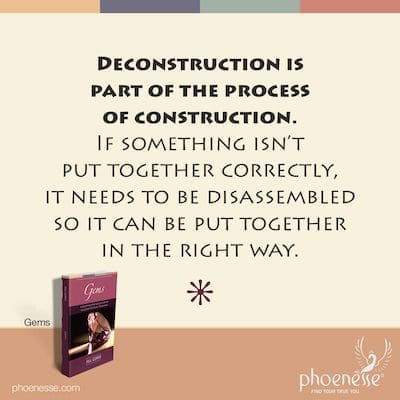Balance is what keeps the universe spinning on its axis. Without balance, the whole place would fall apart. Every natural law we know of—including every supernatural law we know of but don’t understand—is designed to keep things in balance.

Balance isn’t some cold, mechanical factor that runs on lucky coincidence; balance has a purpose and is an expression of supreme intelligence. Although we can find balance in the physical laws that run this planet, we don’t detect many of these laws. Because we can’t perceive how they connect to levels of reality we’re not aware of. But they are there—both the laws of balance and those other levels of reality.
All the planets in every galaxy are held together by these meaningful laws. Without them, the planets would bounce around like billiard balls. Same would happen inside our own bodies. We have not yet discovered the physical law of balance that governs the machinery of the human body. But without it, we would come apart at the seams; we literally wouldn’t be able to hold ourselves together.
Some laws of balance are obvious to scientists. Others are literally beyond us. For the key to creation is held in higher mathematics than most of us, in our current level of reality, can understand. But despite our limits in comprehending the complexity, balance exists on all levels of reality.
When things are out of balance, disorder and disharmony abound. These are the necessary agents of disintegration that will simply and inevitably lead back towards integration and therefore balance. Everything, in the end, is heading in the general direction of balance, including health, intelligence and love.
On this physical level, this means that disorder creates more disorder. But this is only a temporary manifestation on the way to the creation of a higher level of organization. Deconstruction is part of the process of construction. If something isn’t put together correctly, it needs to be dissembled. So then it can be put together in the right way.
On the level of emotions, balance shows up as feelings that are in harmony. And this leads to more harmony. Again, negative and disharmonious feelings will also eventually bring us to a greater order of harmony. But that will happen farther down the road and with greater turmoil along the way. On the mental level, balance looks like sanity. Which means insanity is a temporary stop on the road to saner and higher ground.
If we are in balance, we have things in “the right measure”. Here on this planet of duality, this is the art of holding opposites so they are in balance relative to each other. Like hot and cold. Having both in the right measure is an indispensable part of living. Each serves its own function in the grand scheme of things, and everything is always relative. In one region, a tropical rain may serve to cool down the stifling heat. Meanwhile, in another, such as the arctic, sunshine provides the balance required to sustain life. But when these go out of balance, either blistering heat or icy cold temps have the power to kill.
Or let’s look at light and darkness. When in balance in the outer world, humanity gets exactly what it needs. Only to the dualistic mind do they appear as opposites, but both are needed to form a complete whole. We typically rest in the darkness of night, and are active in the brightness of day. This symbolizes our need for balance between action and rest. When one is emphasized over the other—tilt!—the game of life is temporarily in chaos.
We each hold the intuitive ability to find just the right balance for our particular being to reveal its beauty, wisdom and love. As we cast our creative light out into the world, we are following an evolutionary urge to fill the void with light. When we do this, consciousness and energy lose themselves in the mystery of creation, making it seem as though we separate ourselves from the whole.
This temporary illusion of separation serves a good purpose though—it fulfills the task of bringing light into the void and spiritualizing it. Eventually, through this process, all the gaps get filled in and the original Oneness gets restored. Until this happens, this process of spreading divinity is going to look a lot like a process of creating imbalance, which leads to chaos, which leads to disintegration. But the chaos is a temporary state.
In the imbalance created from the onward motion of our light, as it penetrates the void, we see the illusion of separation; and in separateness, there must be imbalance. Again, this is simply a necessary step in the direction of creating greater balance.
It’s great if we can follow this somewhat convoluted situation with our minds. But better yet, we need to have an intuitive sense of this. It may be easiest to do this by considering areas in our lives where we are out of balance.
When we do the work of uncovering our unconscious bits—largely the stuff hidden by that dastardly old Lower Self—and cleaning them up, we are reestablishing balance. With our frozen blocks freed up, we then find the right measure of things intuitively. We know when it’s right to be outgoing and to what extent, and when we should be gathering ourselves and holding ourselves together. We will know when it’s time to be active, and when we should chill and just be quiet. We’ll find equilibrium and become spontaneous in expressing ourselves; we’ll naturally know when to assert ourselves, and when to be flexible and give in.
But human beings like to find refuge in rules; we like hard and fast directions we can accept without thinking. Really, who wants to have to feel into some deep process about their inner light? So what we’re hoping for is a shortcut when what we really need to find is the spontaneous functioning of our true self—the Godself at the core of each one of us. That’s the part of us that knows just how to be and what to do, in just the right measure, in any situation. The trick in tapping into this fount-of-wisdom is in knowing it’s possible to realize it and consciously wanting to connect with it—but not trying to force it.
It’s the outer ego-mind that must lean on rules, looking to apply pat truisms across the board. But even if rules-based-truths are valid, such an approach will make them stilted. We simply can’t establish the kind of balance we long for using only the surface of our personality. The results will fall flat—an unsatisfying gesture instead of a meaningful action; the latter can only arise from our divine center.
Balance, like qualities such as love, peace and enlightenment, can never be forced from the outside; it’s a divine and spontaneous movement that is a byproduct of doing the work of healing our distorted inner aspects. This may indeed be arduous to do, but it is also certainly satisfying and fulfilling, and leads to sanity as well as health. When our physical and energetic bodies are in balance, we are healthy. Likewise, a healthy body will maintain a healthy balance. Illness, then, is a sign that something is out of balance; it’s not a sign that we are bad, just that we are out of balance.
The same consciousness that nurtures a healthy body will help us lead a balanced life, partly through our intelligence, partly through our intuition, and partly through the right use of our will. But balance doesn’t come by way of a mathematical formula; it’s not a fifty-fifty deal. For example, what’s the right balance between sleep and being awake? While this will vary somewhat from person to person, nobody needs twelve hours of sleep a day. So it may outwardly seem out of balance to get eight hours of sleep followed by sixteen hours of activity, but in terms of inner balance, that sounds about right. The long and short of it: we have to look within to find the right measure.
Imagine, for instance, trying to apply an outer rule for how much time we should spend being assertive versus when we should be in a state of being. That’s as absurd as saying a spiritual person should never be aggressive or that a strong person can never be soft. The balancing factor is beyond mental calculations. We need to get a feel for this within.
Nestled within the apparent unevenness of our inner reality lies the real balance. There’s not a mechanical formula but rather a deeper meaning. When we find it, we feel into the rhythm of life, which is the purpose of being on a spiritual path. But if we’re not connected to the inner dimension, our only choice is to relegate all rhythm and balance and measurements—aka, rules—to the outer mind.
But the outer mind has no sense of true proportion; it can only operate according to rules. And that stilted way of being breaks the real balance. Find the inner being, though, and look out. Its vibrant intelligence and wisdom will surpass what the outer mind could ever come up with. We will experience the grandeur of being held together by a beautiful balancing system that defies expression in words. This is what we need to learn to trust; this is what we want to learn to go with, deliberately consulting this ever-available balancing system, opening to it and becoming more and more awake to it.
If we tune into the rhythm of the balancing factors, we’ll feel into how we are a vital cog in a finely working machine. We can give up the temptation to stay in our temporarily smaller area, and trust that we can find the larger order of our greater mind. So when things go wrong in our world, when the imbalance and chaos make us want to rebel, we can let go of the battle and find ourselves in inner order and balance. We do this by making room for it, having faith in it, and waiting for it to surface.
As we turned the corner from the last century into the current one, new Christ consciousness is emerging on an inner level of reality. As it breaks through, it must destroy older, outdated attitudes and concepts. This destruction happens in the little everyday matters of life, and if we can grasp the inner meaning of this, we will be able to make new order from the temporary disorder. In this way, we will establish a truer balance that is more profound and meaningful—not so superficial.
We’re ready for something more real; we’ve outgrown superficial ways of being. But then the Lower Self steps in, deliberately creating imbalance as if to prove ‘nothing works.’ And darned if we don’t then get confirmation that nothing works. Whatever we do is wrong—out of step, as it were—life is no good and we may just as well pack it in. This is the compelling argument made by the listing Lower Self.
We need to be aware of this if we want to wrest control from the wily ways of the Lower Self. Then we can open our hearts and minds to our Higher Self, asking for guidance and help in finding balance; the mind will never find this on its own.
If we are ignorant of the importance and reality of balance, we won’t see, for example, that both work and play have a place in life. Or we won’t recognize that some measure of abstinence is needed for fulfillment to avoid being shallow; then being out of balance is self-defeating.
We need to give to ourselves to a certain extent, and then stop. We need to sense the force within that governs how much to give and when; then we need to call on this force. When we do this, we cultivate a concept of balance, finding harmony between two halves that currently seem to be in opposition. As our understanding of this concept ripens, our Lower Self will no longer get away with its game, because we will meet it with the intrinsically life-balancing light of truth.
Return to Gems Contents



